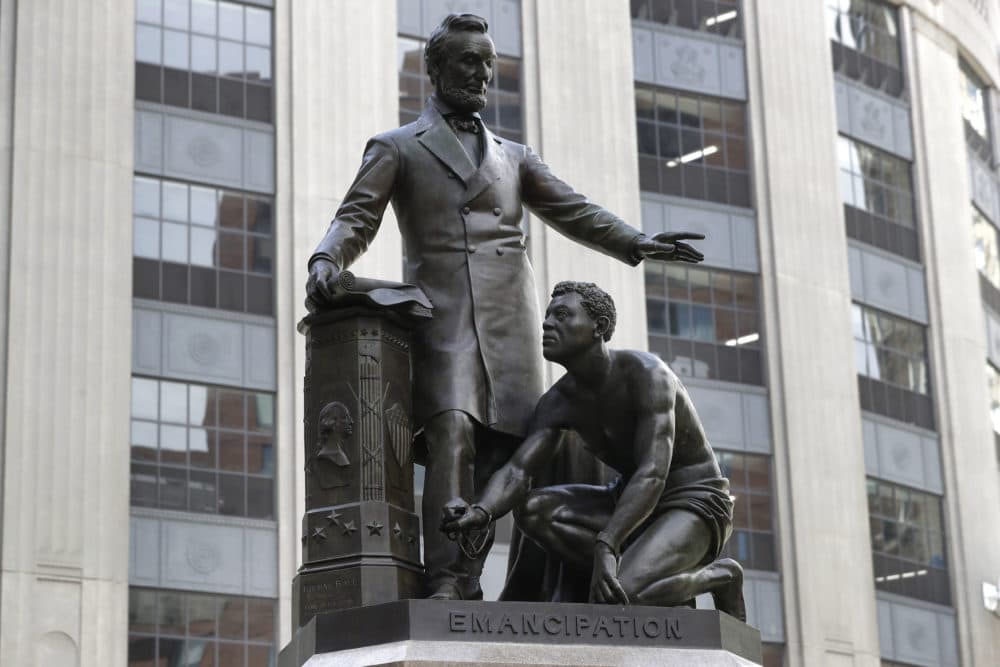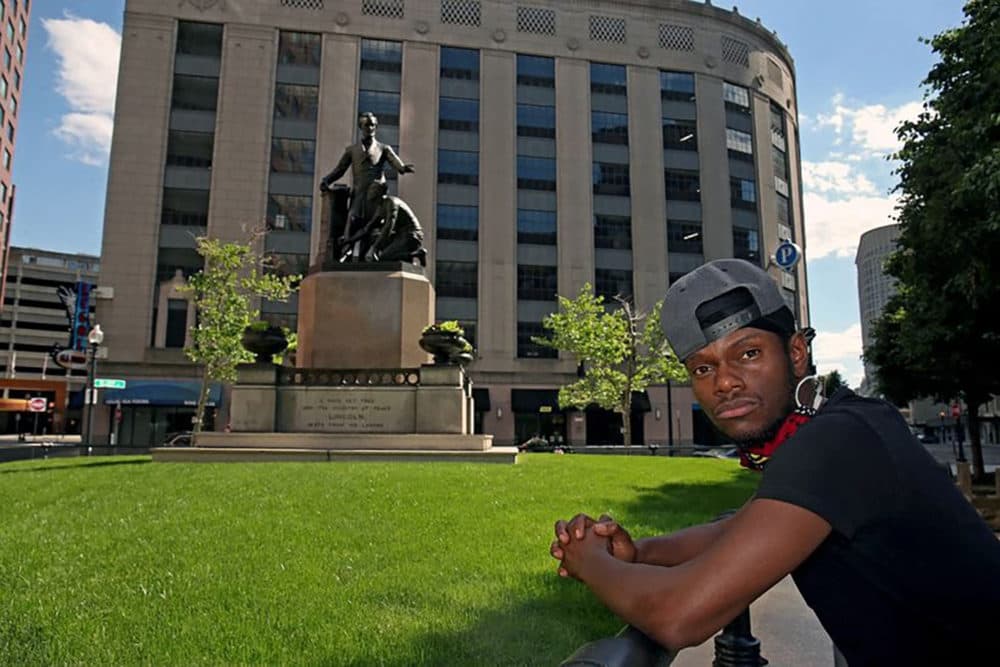Advertisement
Boston Artist Doesn't See Freedom In Lincoln Statue Featuring Enslaved Man, Calls For Removal
Resume
When Boston artist Tory Bullock looks at the Emancipation Memorial in Boston's Park Square, he sees subservience instead of freedom.
Designed and erected in 1876, the statue depicts Lincoln holding the Emancipation Proclamation as he frees an enslaved Black man modeled on Archer Alexander — who is shirtless, kneeling by the president's feet with broken shackles on his wrists and ankles.
The statue, which is thought to be the first of a Black man in this country, is a replica of the Washington, D.C., statue by sculptor Thomas Ball.
Bullock says the memorial shows a Black man in a degrading position as though "he's a coffee table or a pet,” while Lincoln is standing tall over him, depicted with “impeccable” details from his beard to his pupils.
For Bullock, it looks like the Black man in the memorial is “frozen in time” on his knees.
“This man will never stand. He will always be on his knees,” he says. “So for me, I see a white savior helping people who would have never been able to do it on their own.”
It's time to remove the Emancipation Memorial and move it to a museum where it’ll be better suited, Bullock argues. Thousands of people have signed his online petition to “finally respectfully put this image away while never forgetting its history.”
Instead of removing the statue for good, Bullock says this is a chance to transport the “great craftsmanship” from the public sphere into a museum and use it as a learning opportunity. Currently, there’s no plaque at the monument in which viewers can read about the history of the statue or the real story of Archer Alexander, who helped the Union during the Civil War.
“I think to put it into a space where we can actually acknowledge that history would be 30 times better than actually leaving it up in public right now,” he says.

Interview Highlights
On his reaction to the memorial as a child
“... I remember the first time I saw it downtown, this highly controversial piece of art is nestled right in Park Square in Boston between Maggiano's and Legal Seafood. So I was on my way down there with my family to go get something to eat and I vividly remember seeing this statue, seeing a person that looked just like me on his knees. So that's a journey that started when I was a child and I'm a grown man and it's still sitting with me.
“There is a physical reaction, I think. Well, it was very jarring when I first saw it as a child, like, ‘Whoa, what is this?’ But being completely honest, now it’s kind of just a numb, dulling, ‘Why is it still up?’ emotion whenever I see it. Whenever I pass it, it just really reminds me of what people's perception of me is. And it feels less about, hey, you should remember your proud ancestors and your proud history, and it feels more about you should remember your place because you're beneath me.”
On the dissenting argument that formerly enslaved Black people paid for the statue and that Black Americans should be proud of Alexander’s story
“That's one of the main arguments I hear people have, is that, ‘Hey, guys, you should be proud of this. This is your story of Archer Alexander.’ It really makes me feel like so if he's really one of the most powerful African American figures that we have in our history, why do we have a statue of him naked? No one would ever want to see a statue of President Lincoln without a shirt and pants on.
“And in terms of the ‘we paid for it’ argument, my favorite response to that is actually a quote, if you don't mind me reading it right now. It says: ‘$17,000 was raised to fund the memorial — an enormous sum coming from a newly emancipated people. Predictably (and this is important), none of these donors had a say in the monument’s design. Instead, the all-white commission led by Rev. William G. Eliot set out to find a suitable tribute. Eliot met with Massachusetts-born artist Thomas Ball.’
“This was written on Medium.com by Raul Fernandez. Those Black people who were involved put their money up. They weren't involved in the creative process. So it's not even their vision.”
“I think that there's this fear that by somehow getting rid of this statue that all Black Americans are going to forget that slavery happened. And I can guarantee you that the 400 to 500 years that African Americans spent in slavery left such an imprint that we will remember it if we don't see a statue reminding us of it all the time.”
On if there’s a way to keep the original standing and create another Alexander statue nearby
“For me, two things. First, I am a creative. I'm an artist myself. And I think that would actually be pretty disrespectful to kind of put something attached to or around to influence this kind of piece of art. I don't want to touch the art itself at all. And I also think that putting something kind of a standing Archer Alexander fully clothed and putting that next to him, it is still, always remember, that he was a slave. Every movie that comes out about my Black history is about slavery, our images are slavery. I just don't understand. It feels like everyone else is way more obsessed with continuing to carry the image of slavery than actual Black people are.”
On what next steps he’d like to see taken with the Emancipation Memorial
“Honestly, I think there's an amazing opportunity. What I want to see, I don't even want to see this thing destroyed, I don't want to see it melted down. I don't want to see it pulled down violently. A lot of effort and work went into that piece. And I truly respect this piece of artwork. Now, that's not something I can say at the beginning of this, but I do respect this piece of artwork. And because I respect it, I feel like this should be put in a museum somewhere where we can learn about it and have these articulate conversations that we want to have, but we can have it inside of a proper space for it and not next to Legal Seafood out in public.
“And the process in which to get there is something that I feel that the entire country can look at and say, ‘Hey, this is how we can do this.’ Instead of just ripping down these statues, we can gather the public support, make some noise, and then our city officials are going to have to create a process for us to actually facilitate that.
“I’m telling you, I really feel like putting it in a museum is the ultimate compromise, putting them in an organized space where they can truly be curated. I can walk and see the Emancipation Memorial and see all of the history, all of the love that went into it. All of the money that went into it. Because as awesome as this history is that everyone's bringing up about this memorial now, no one knew this. No one was talking about this.”
Karyn Miller-Medzon produced and edited this interview for broadcast with Robin Young. Serena McMahon adapted it for the web.
This segment aired on June 29, 2020.
